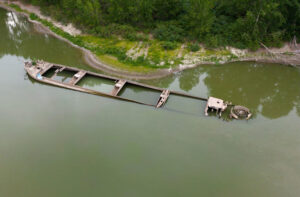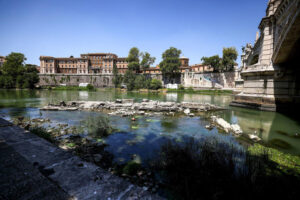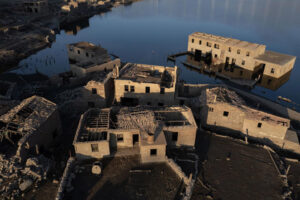AUGUST 12, 2022
Extreme heat this year has triggered wildfires, drought and melting glaciers. Less expectedly, it’s also revealed some weird and dark things about our past—shipwrecks, corpses, ghost villages, ornamental gardens and ancient cities. Here’s a look at some of th
Roman Remains
Italy’s drought has revealed artifacts from World War II and a glimpse of life under Nero.

Europe – Italy Daily Life 2022. – Photographer: Ciancaphoto Studio/Getty Images
Months without rain and an earlier-than-usual halt in flows from melting snow in the Alps depleted the River Po—Italy’s longest river—to its lowest level in 70 years. The dried-up riverbed revealed previously hidden World War II-era wreckage such as a German tank and cargo ships.

Low Water Levels On Rome’s River Tiber As Italy Declares State of Emergency on Impact From Drought
In Rome, meanwhile, drought sapped the River Tiber and unveiled a bridge that’s thought to have been built during Emperor Nero’s rule. This summer’s extremely hot and dry conditions in Italy forced the government to declare a state of emergency in July.
Spanish Ghost Village
A town stuck in the early 1990s has re-emerged in Galicia, Spain.

Ghost Village Emerges From Reservoir Amid Spanish Drought. – Photographer: Gonalo Fonseca/Bloomberg
Aceredo, a village near Spain’s border with Portugal, was flooded in 1992 to make room for the Alto Lindoso reservoir. In February—about 30 years later—drought re-exposed the small town. Soon, tourists began flocking to see a place frozen in time.
Scientists expect Galicia to continue suffering from extreme dry spells. “Rainfall and drought patterns are always more complex, more difficult to predict scientifically,” said Jofre Carnicer, Barcelona-based climate researcher and an author of the Intergovernmental Panel on Climate Change’s sixth assessment. “The risk of drought in the next decades in this area will increase.”
Grim Discoveries
Lake Mead unveils a creepy collection of the desert’s history.
Some US reservoirs that should’ve brimmed with snowmelt in the spring instead had bathtub rings of dry dirt, including Lake Mead. The lake fell this year to a record low.
Lake Mead—the massive reservoir at the iconic Hoover Dam—has shrunk to a fraction of its former self to become a site of ghoulish curiosity.
Visitors have come across everything from sunken boats to dead bodies. “We could find everything from a missing jet ski to more bodies,” said Michael Green, an associate professor of history at the University of Nevada, Las Vegas. “As the water recedes, we will find more.”
The human remains discovered at the site include a body in a barrel, according to the US National Park Service. The cause of death is under investigation.
Officials with the Clark County Office of the Coroner/Medical Examiner and the Las Vegas Metropolitan Police Department declined to comment further.
Shackleton’s Wreckage
Scientific expedition cracked a cold case in Antarctic ice.
On Feb. 25, Antarctic sea ice cover shrank to a satellite-era record low level—which may have helped solve one of the greatest mysteries in maritime history. Around that time, a crew set off on a research vessel from South Africa to the depths of the Weddell Sea, a remote area of the Antarctic coastline, to locate, survey and film the wreckage of Sir Ernest Shackleton’s ship Endurance. The exact whereabouts of the famous explorer’s ship was long unknown; it had been trapped and crushed by thick Antarctic sea ice in 1915.
The 35-day mission was tough. The team had to navigate choppy waters and still quite a bit of frozen hazards despite ice extent being below average. Using an autonomous vehicle, the wreck was found more than 3,000 meters (9,843 feet) underwater.
Secret Garden
UK heat wave has unearthed a florid 17th century landscape.
Extreme summertime heat in Britain has scorched the south lawn at a historic home in central England, revealing a hidden 17th century garden. Broad, ornate patterns can be seen on the lawn at Chatsworth House in Derbyshire.
Dubbed the Great Parterre, the extensive garden dates to 1699 and was once filled with flowerbeds and paths. By 1730, the ornate landscape was grassed over and because the new lawn has shorter roots it burns more quickly. On July 26, Chatsworth logged a temperature of 38.1℃ (100.6℃)—this was the highest on record for more than 100 years, according to information on the historic home’s site.
Mesopotamian Treasure
A Bronze-Age empire’s urban center has reappeared in Iraq.
From a dried-up area of Iraq’s Mosul reservoir this year, the ruins of an extensive, ancient city surfaced. A team of Kurdish and German archeologists rushed to investigate the site of Kemune, an ancient city on the Tigris River that flourished under the Mitanni Empire from 1550 to 1350 B.C.—during the Bronze Age.
The research team found ceramic vessels reportedly containing more than 100 cuneiform tablets. The discovery could provide more details about the end of the Mitanni-period city and the start of Assyrian rule in the region. “It is close to a miracle that cuneiform tablets made of unfired clay survived so many decades under water,” said University of Tübingen Professor Peter Pfälzner, who was part of the rescue excavations at Kemune, in a press release.
Hunting Relics
Melting glaciers have uncovered millennium-old artifacts in Norway.
In the high mountains of Norway, odd artifacts uncovered by glacial archaeologist Lars Pilø and his team at the Glacier Archaeology Program included a woolen tunic from the Iron Age as well as a Roman-style shoe and a well-preserved arrow with fletching still attached from the years 300 to 600. The arrow is a relic from a reindeer hunting site.
“With the continued melt of high mountain ice, we expect to see more sites appearing and even older finds melting out,” said Pilø, whose team has found thousands of Iron Age and the Early Medieval Period items from ice sites across Norway over the last 15 years. “We are melting back in time, as the ice retreats.”

































































































